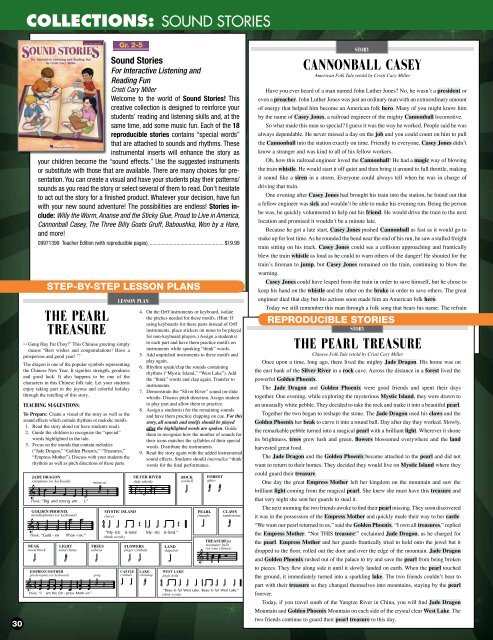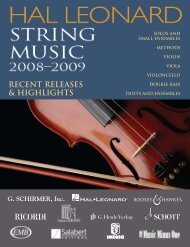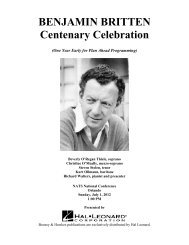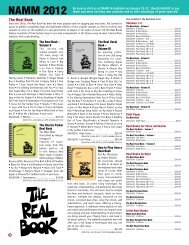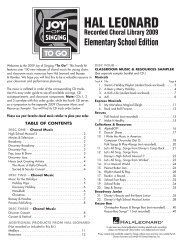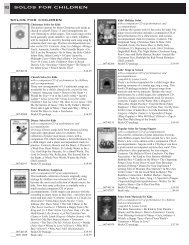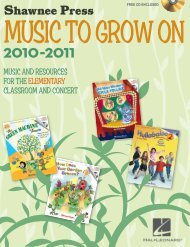musicals - Hal Leonard
musicals - Hal Leonard
musicals - Hal Leonard
You also want an ePaper? Increase the reach of your titles
YUMPU automatically turns print PDFs into web optimized ePapers that Google loves.
Collections: Sound Stories<br />
22<br />
30<br />
Sound Stories<br />
For Interactive Listening and<br />
Reading Fun<br />
Cristi Cary Miller<br />
Welcome to the world of Sound Stories! This<br />
creative collection is designed to reinforce your<br />
students’ reading and listening skills and, at the<br />
same time, add some music fun. Each of the 18<br />
reproducible stories contains “special words”<br />
that are attached to sounds and rhythms. These<br />
instrumental inserts will enhance the story as<br />
your children become the “sound effects.” Use the suggested instruments<br />
or substitute with those that are available. There are many choices for presentation.<br />
You can create a visual and have your students play their patterns/<br />
sounds as you read the story or select several of them to read. Don’t hesitate<br />
to act out the story for a finished product. Whatever your decision, have fun<br />
with your new sound adventure! The possibilities are endless! Stories include:<br />
Willy the Worm, Ananse and the Sticky Glue, Proud to Live in America,<br />
Cannonball Casey, The Three Billy Goats Gruff, Baboushka, Won by a Hare,<br />
and more!<br />
09971399 Teacher Edition (with reproducible pages) ........................................................ $19.99<br />
Gung Hay Fat Choy!” This Chinese greeting simply<br />
“ means “Best wishes and congratulations! Have a<br />
prosperous and good year!<br />
JADE DRAGON<br />
xylophone<br />
& 4 (or keyboard)<br />
œ œ œ œ<br />
Think: “Big and strong am<br />
GOLDEN PHOENIX<br />
metallophones (or keyboard)<br />
& 4 4<br />
˙<br />
˙<br />
Sound StorieS<br />
˙<br />
˙<br />
˙<br />
I.”<br />
maracas<br />
‹ @ Œ<br />
leSSon Plan<br />
CLAWS<br />
tambourine<br />
‹ @<br />
“My-stic Is-land My - stic Is-land.”<br />
Think: “Gold - en Phoe - nix.” (think words)<br />
TREASURE(s)<br />
BEAK<br />
LIGHT TREES<br />
FLOWERS<br />
LAND<br />
resonator bells<br />
wood block wind chime cabasa<br />
(or tone chimes)<br />
slapstick<br />
‹ ‹ @ finger cymbals<br />
‹<br />
& 44 œ œ Ó<br />
‹ ‹<br />
EMPRESS MOTHER<br />
glockenspiels (or keyboard)<br />
& 4 œ<br />
the Pearl<br />
treaSure<br />
œ œ œ Think: “I am the Em - press Moth-er.”<br />
œ œ<br />
”<br />
The dragon is one of the popular symbols representing<br />
the Chinese New Year. It signifies strength, goodness<br />
and good luck. It also happens to be one of the<br />
characters in this Chinese folk tale. Let your students<br />
enjoy taking part in the joyous and colorful holiday<br />
through the retelling of this story.<br />
teaChing SuggeStionS:<br />
To Prepare: Create a visual of the story as well as the<br />
sound effects which contain rhythms or melodic motifs.<br />
1. Read the story aloud (or have students read).<br />
2. Guide the children to recognize the “special”<br />
words highlighted in the tale.<br />
3. Focus on the sounds that contain melodies<br />
(“Jade Dragon,” “Golden Phoenix,” “Treasures,”<br />
“Empress Mother”). Discuss with your students the<br />
rhythms as well as pitch directions of these parts.<br />
œ<br />
œ<br />
gong<br />
‹ Œ<br />
Gr. 2-5<br />
step-by-step lesson plans<br />
4<br />
MYSTIC ISLAND<br />
4 claves<br />
CASTLE<br />
cymbals<br />
‹ ‹<br />
SILVER RIVER<br />
slide whistle<br />
4<br />
O O<br />
~~<br />
4 ‹ ‹ ‹ ‹ Œ<br />
4. On the Orff instruments or keyboard, isolate<br />
the pitches needed for these motifs. (Hint: If<br />
using keyboards for these parts instead of Orff<br />
instruments, place stickers on notes to be played<br />
for non-keyboard players.) Assign a student(s)<br />
to each part and have them practice motifs on<br />
instruments while speaking “think” words.<br />
5. Add unpitched instruments to these motifs and<br />
play again.<br />
6. Rhythm speak/clap the sounds containing<br />
rhythms (“Mystic Island,” “West Lake”). Add<br />
the “think” words and clap again. Transfer to<br />
instruments.<br />
7. Demonstrate the “Silver River” sound on slide<br />
whistle. Discuss pitch direction. Assign student<br />
to play part and allow them to practice.<br />
8. Assign a student(s) for the remaining sounds<br />
and have them practice clapping on cue. For this<br />
story, all sounds and motifs should be played<br />
after the highlighted words are spoken. Guide<br />
them to recognize how the number of sounds for<br />
their icons matches the syllables of their special<br />
words. Distribute the instruments.<br />
9. Read the story again with the added instrumental<br />
sound effects. Students should internalize “think”<br />
words for the final performance.<br />
~~~<br />
LAKE<br />
vibraslap<br />
‹ @<br />
O Ó<br />
‹ ‹ ‹ ‹ Œ<br />
4<br />
‹<br />
WEST LAKE<br />
jingle bells<br />
4<br />
ROCK<br />
cowbell<br />
‹<br />
‹ ‹ ‹ ‹ ‹<br />
PEARL<br />
triangle<br />
‹<br />
FOREST<br />
güiro<br />
‹ @ ‹ @<br />
‹ ‹ ‹ ‹ ‹<br />
“Beau-ti-ful West Lake. Beau-ti - ful West Lake.”<br />
(think words)<br />
StorY<br />
Cannonball CaSeY<br />
American Folk Tale retold by Cristi Cary Miller<br />
Have you ever heard of a man named John Luther Jones? No, he wasn’t a president or<br />
even a preacher. John Luther Jones was just an ordinary man with an extraordinary amount<br />
of energy that helped him become an American folk hero. Many of you might know him<br />
by the name of Casey Jones, a railroad engineer of the mighty Cannonball locomotive.<br />
So what made this man so special? I guess it was the way he worked. People said he was<br />
always dependable. He never missed a day on the job and you could count on him to pull<br />
the Cannonball into the station exactly on time. Friendly to everyone, Casey Jones didn’t<br />
know a stranger and was kind to all of his fellow workers.<br />
Oh, how this railroad engineer loved the Cannonball! He had a magic way of blowing<br />
the train whistle. He would start it off quiet and then bring it around to full throttle, making<br />
it sound like a siren in a storm. Everyone could always tell when he was in charge of<br />
driving that train.<br />
One evening after Casey Jones had brought his train into the station, he found out that<br />
a fellow engineer was sick and wouldn’t be able to make his evening run. Being the person<br />
he was, he quickly volunteered to help out his friend. He would drive the train to the next<br />
location and promised it wouldn’t be a minute late.<br />
Because he got a late start, Casey Jones pushed Cannonball as fast as it would go to<br />
make up for lost time. As he rounded the bend near the end of his run, he saw a stalled freight<br />
train sitting on his track. Casey Jones could see a collision approaching and frantically<br />
blew the train whistle as loud as he could to warn others of the danger! He shouted for the<br />
train’s fireman to jump, but Casey Jones remained on the train, continuing to blow the<br />
warning.<br />
Casey Jones could have leaped from the train in order to save himself, but he chose to<br />
keep his hand on the whistle and the other on the brake in order to save others. The great<br />
engineer died that day but his actions soon made him an American folk hero.<br />
Today we still remember this man through a folk song that bears his name. The refrain<br />
of the song that goes like this: “Casey Jones, mounted his cabin. Casey Jones, with his<br />
reproducible stories<br />
orders in his hand. Casey Jones, mounted to his cabin, and he took his farewell trip to the<br />
StorY<br />
Promised Land.”<br />
the Pearl treaSure<br />
Copyright © 2008 by HAL LEONARD CORPORATION<br />
International Copyright Secured All Rights Reserved<br />
The original purchaser of this book has permission to reproduce this story for educational use in one school only. Any other use is strictly prohibited.<br />
Chinese Folk Tale retold by Cristi Cary Miller<br />
Sound StorieS 27<br />
Once upon a time, long ago, there lived the mighty Jade Dragon. His home was on<br />
the east bank of the Silver River in a rock cave. Across the distance in a forest lived the<br />
powerful Golden Phoenix.<br />
The Jade Dragon and Golden Phoenix were good friends and spent their days<br />
together. One evening, while exploring the mysterious Mystic Island, they were drawn to<br />
an unusually white pebble. They decided to take the rock and make it into a beautiful pearl.<br />
Together the two began to reshape the stone. The Jade Dragon used his claws and the<br />
Golden Phoenix her beak to carve it into a round ball. Day after day they worked. Slowly,<br />
the remarkable pebble turned into a magical pearl with a brilliant light. Wherever it shone<br />
its brightness, trees grew lush and green, flowers blossomed everywhere and the land<br />
harvested great food.<br />
The Jade Dragon and the Golden Phoenix became attached to the pearl and did not<br />
want to return to their homes. They decided they would live on Mystic Island where they<br />
could guard their treasure.<br />
One day the great Empress Mother left her kingdom on the mountain and saw the<br />
brilliant light coming from the magical pearl. She knew she must have this treasure and<br />
that very night she sent her guards to steal it.<br />
The next morning the two friends awoke to find their pearl missing. They soon discovered<br />
it was in the possession of the Empress Mother and quickly made their way to her castle.<br />
“We want our pearl returned to us,” said the Golden Phoenix. “I own all treasures,” replied<br />
the Empress Mother. “Not THIS treasure!” exclaimed Jade Dragon, as he charged for<br />
the pearl. Empress Mother and her guards frantically tried to hold onto the jewel but it<br />
dropped to the floor, rolled out the door and over the edge of the mountain. Jade Dragon<br />
and Golden Phoenix rushed out of the palace to try and save the pearl from being broken<br />
to pieces. They flew along side it until it slowly landed on earth. When the pearl touched<br />
the ground, it immediately turned into a sparkling lake. The two friends couldn’t bear to<br />
part with their treasure so they changed themselves into mountains, staying by the pearl<br />
forever.<br />
Today, if you travel south of the Yangtze River in China, you will find Jade Dragon<br />
Mountain and Golden Phoenix Mountain on each side of the crystal clear West Lake. The<br />
two friends continue to guard their pearl treasure to this day.<br />
Sound StorieS 23


